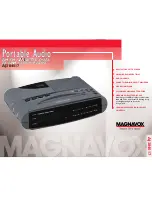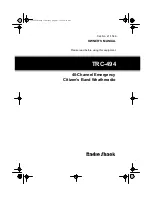
©
2002 RadioShack Corporation.
All Rights Reserved.
RadioShack, RadioShack.com, and Adaptaplug are trademarks used by RadioShack Corporation.
21-1863
OWNER’S MANUAL — Please read before using this equipment.
The Family Radio Service (FRS) is a
license-free, two-way, short-range voice
radio service that lets families and groups
keep in touch with each other on specific
reserved channels.
Your RadioShack 14-Channel Personal
Radio is a lightweight, palm-sized radio you
can use to talk with another person who has
a FRS radio set to the same frequency as
your radio.
Your radio has auto-squelch, so you will not
hear anything on a channel unless someone
is transmitting nearby on the same channel.
You can use the
MON
(monitor) key to
temporarily turn off auto-squelch to hear
weaker, distant transmissions.
You can connect an optional speaker/
microphone and earphone to the radio
(neither supplied, available at your local
RadioShack store).
+056#..+0)
"
$#66'4+'5
Your radio requires 4 AAA alkaline or
rechargeable nickel-cadmium (Ni-Cd)/
nickel-metal hydride (Ni-MH) batteries (not
supplied) for power. For the best
performance and longest life, we
recommend RadioShack batteries.
Rý
.
.
.
.
You can also recharge Ni-Cd or Ni-MH
batteries inside the radio at home or in your
vehicle, using a 6V, 600mA AC or DC
adapter and a size F Adaptaplug
TM
connector (neither supplied). Both adapters
and the Adaptaplug are available at your
local RadioShack store.
Rý
.
.
.
.
1. Rotate
VOLUME/ON/OFF
counterclockwise until it clicks.
2. Slide the battery compartment cover in
the direction of the arrow to remove it.
3. Slide
CHARGE ON/OFF
inside the
battery compartment to
OFF
(for
alkaline batteries) or
ON
(for Ni-Cd or
Ni-MH rechargeable batteries).
4. Place the batteries in the compartment
as indicated by the polarity symbols (+
and –) marked inside.
5. Replace the cover. Then rotate
VOLUME
ON/OFF
clockwise until it clicks to turn
on the radio. If you installed alkaline
batteries, stop here.
6. If you installed rechargeable batteries,
attach the Adaptaplug to the adapter so
TIP reads positive (+).
7. Connect the Adaptaplug’s other end to
DC 6V
, then plug the adapter into a
standard AC outlet or your vehicle’s
cigarette-lighter adapter.
±
Complete charging takes about 10 hours.
Average charging time varies, depending on
capacity. Typically, Ni-MH batteries charge
in about 10 hours. Ni-Cd batteries charge in
about 4 hours.
When charging is complete, unplug the AC
or DC adapter from the power source, then
disconnect it from the radio’s
DC 6V
jack.
#
The battery icon’s segments appear to show
how much power remains. When the battery
icon’s three segments flash or the radio
stops operating, replace or recharge the
batteries.
14 Channels – provide clear
communication for up to two miles.
Channel Scan – helps you find
other FRS users (see “Operation”
on Page 2).
38 Quiet Codes –
eliminate interference
from other radios that
are not tuned to the
same channel and quiet
code as your radio (see
“Using Quiet Codes” on
Page 2).
Courtesy Tone – sounds at the
end of a conversation as an end-of-
message acknowledgement (see
“Setting the Courtesy Tone” on
Page 3).
Key Tone– sounds to
show that you pressed
a key (see “Setting the
Key Tone” on Page 3).
Lock – locks the
SCAN/
¼ý
,
¹
/CALL
and
MENU/QUIET
keys (see “Using Key
Lock” on Page 2).
%106'065
Installing Batteries ....................................... 1
Operation .................................................... 2
Using Quiet Codes ................................... 2
Using Key Lock ........................................ 2
Setting the Courtesy Tone ........................ 3
Using the Backlight .................................. 3
Setting the Key Tone ................................ 3
Using the Swivel Belt Clip ........................ 3
Using an Optional Wrist Strap .................. 3
Care ............................................................ 3
Service and Repair ...................................... 3
FCC Information .......................................... 3
Safety Information ....................................... 3
Specifications .............................................. 4
#
"
+/2146#06
"
#
If an icon appears at the end of a paragraph,
go to the box on that page with the
corresponding icon for pertinent information.
Rý
— Warning
#
— Important
.
.
.
.
— Caution
°
°
°
°
— Hint
±
— Note
R
"
9#40+0)
ý
R
"
•
Do not attempt to charge alkaline batteries.
Non-rechargeable batteries can get hot or
explode if you try to recharge them.
•
Never install non-rechargeable batteries
when CHARGE ON/OFF is set to ON. Non-
rechargeable batteries can get hot or
explode if you try to recharge them.
•
Dispose of old batteries promptly and
properly. Do not burn or bury them.
.
"
%#76+10
"
.
You must use a Class 2 power
source that supplies regulated
6V DC and delivers at least 600
mA. Its center tip must be set to positive and
its plug must fit the radio's DC 6V jack. Using
an adapter that does not meet these specifi-
cations could damage the radio or the adapter.
•
Always connect the AC adapter to the radio
before you connect it to AC power. When you
finish, disconnect the adapter from AC power
before you disconnect it from the radio.
•
Use only fresh batteries of the required size
and recommended type.
•
Do not mix old and new batteries, different
types of batteries (standard, alkaline, or
rechargeable), or rechargeable batteries of
different capacities.
•
If you do not plan to use the radio for a
month or more, remove the batteries.
Batteries can leak chemicals that can
destroy electronic parts.
!
±
"
016'
"
±
"
You can use your radio while charging the
batteries if you connect it to a DC-DC
regulated and filtered adapter (such as
RadioShack Cat. No. 273-1859), but not if you
connect it to an AC-DC regulated adapter
(such as Cat. No. 273-1762).
36/
%JCPPGN
"
2GTUQPCN
"
4CFKQ
YKVJ
"
.%&
"
&KURNC[
"
CPF
"5:"
3WKGV
"
%QFGU
21-1863.fm Page 1 Friday, June 7, 2002 3:23 PM






















